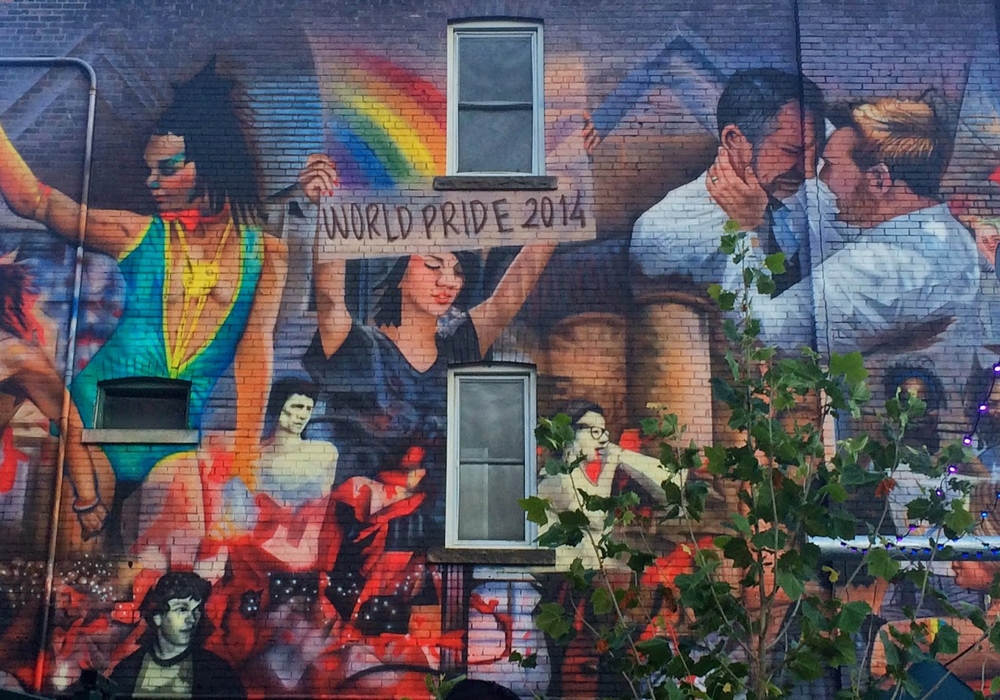Angela Zhu, Contributor
Featured image courtesy of 2moms2dogs2babies.com
Anyone who has wandered along Church Street while revelling in Toronto’s annual Pride Week will recognize the dazzling, rainbow-lit pride house just north of the Church and Wellesley intersection. But those of us who live in the neighbourhood know it simply as “The 519” (pronounced “five-nineteen”).
Admittedly, much like other forms of Toronto lingo, The 519 was a bit confusing for me to figure out. Nicknames like “the 6ix” or “Beaches” come to mind. Most community centres are named after the neighbourhood it serves, or perhaps an individual who helped to found it. The 519, by contrast, is named simply for its street address. It isn’t clear why the street name was dropped from the name, but in practice, everyone knows it isn’t necessary: The 519 is ubiquitous, not just within the vibrant Church-Wellesley Village that it serves, but across Toronto.
The 519 is characterized by its tall, rectangular, brownstone structure, which stands out on a street surrounded by so many modern buildings and fast-food restaurants. On its northern wall stands a new mural, as part of a City of Toronto initiative to add a splash of colour to the neighbourhood in preparation for hosting World Pride 2014. The mural celebrates diversity in all its forms, including sexual and gender diversity, but also highlights different ethnicities, family structures, lifestyles, hobbies, among others.
But perhaps what is most noticeable about the building is the perpetual crowd of community members lounging on its steps or on the benches in the adjacent park. This, I would suggest, is a testament to its growth as a truly successful community centre. Not only has The 519 become a place that serves the community, but locals also know it as a hub where they can meet and interact with their neighbours.
Established in 1975 by the City of Toronto, The 519 set history from its inception by becoming Toronto’s first-ever community centre where programming was controlled by a board of directors made up entirely of volunteers.
The now-defunct North Jarvis Community Association was committed to continuing The 519’s legacy of setting precedents, as member Millie Greenfield wrote in a May 1977 newsletter, those who oversaw the community centre must not “disregard the activist political roots from which we have grown.”
In its first year, The 519’s board voted to provide support to a local group of gay youth – a vote that passed narrowly by a single vote cast by a then-closeted bisexual member. At its Second Annual Meeting, The 519 resolved to recognize the legitimate rights of local “street people” to use the community centre. This was a move that set The 519 down a trajectory toward serving a wide range of people in the community, including the marginalized and the homeless.
To this day, The 519 continues to be a place where activism strives in downtown Toronto. It has hosted many organizing meetings for annual Pride festivities, as well as demonstrations and rallies in support for legislation to give rights and protection for gender identity, marriage equality, and anti-discrimination. During the city-wide panics over HIV in the 1980s that led to controversial bathhouse arrests, The 519 served as a safe haven where LGBTQ+ people could feel safe from persecution. The AIDS Memorial, designed by local artist Patrick Fahn, was erected in the park behind The 519 in 1993 to commemorate Toronto’s victims of HIV. It stands there to this day, surrounded by a garden where local community members can stroll, socialize, and remember the damage that is done when a society stigmatizes a disease rather than address the health concerns.
Thanks to an injection of funding from the City of Toronto in preparation for WorldPride 2014, The 519 was able to fund much-needed renovations to their building. More noticeably, the adjacent Barbara Hall Park was expanded to include benches, a playground, and rainbow-lit shelters, giving The 519 a colourful and festive look year-round and affording the community even more outdoor public space to lounge and socialize.
Today, The 519 serves hundreds of groups in the community; queer literature groups meet to socialize over books; drag performers use the space to rehearse; Pride Toronto organizers meet to plan the following year’s events; psychological and emotional support groups for marginalized LGBTQ+ youth. Since its mandate is to serve the LGBTQ+ community, those who live outside of Toronto – including visitors from other countries – are welcome to drop by to be a part of the community.
As The 519 is a city-funded community centre, it also serves all other activist organizations in the neighbourhood. Any other groups who wish to book the space can use the meeting rooms for free too, so long as they’re queer-friendly (a fairly easy requirement among community organizations downtown).
The friendly front desk staff are always very welcoming, non-judgemental, and quite willing to help point newcomers toward the right community resource or organization that they’re interested in. Many times I have watched Albin, a long-time front desk scheduler, cool the jittery nerves of a newly out LGBTQ+ youth who had arrived at The 519 for the first time.
You’ll be sure to see plenty of friendly faces if you come by the buzzing community centre. And even if you just want to drop by to say hello, there’ll be someone else around looking for the same. That’s the magic of this place: before you know it, you’ll be sucked into this wonderful, welcoming space beneath a massive LED rainbow.
Like us on Facebook, @excalweb


